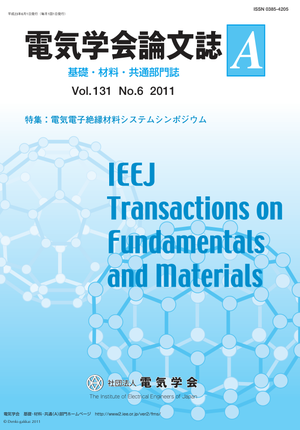電力ケーブルの水トリー劣化位置標定を目指したパルス応答測定
電力ケーブルの水トリー劣化位置標定を目指したパルス応答測定
カテゴリ: 論文誌(論文単位)
グループ名: 【A】基礎・材料・共通部門
発行日: 2011/06/01
タイトル(英語): Pulse Response Measurement Aiming for Locating Water Tree Degradation in XLPE Cables
著者名: 樋江井 進(愛知工業大学),穂積 直裕(愛知工業大学),栗原 隆史((財)電力中央研究所),岡本 達希((財)電力中央研究所),内田 克己(中部電力(株)),辻 泰三(中部電力(株))
著者名(英語): Susumu Hiei (Aichi Institute of Technology), Naohiro Hozumi (Aichi Institute of Technology), Takashi Kurihara (Central Research Institute of Electric Power Industry), Tatsuki Okamoto (Central Research Institute of Electric Power Industry), Katsumi Uchida (Electric Power R & D Center, Chubu Electric Power Co., Inc.), Taizo Tsuji (Electric Power R & D Center, Chubu Electric Power Co., Inc.)
キーワード: 電力ケーブル,劣化診断,水トリー,残留電荷法 power cable,diagnosis,water tree,residual charge method
要約(英語): Water treeing is a degradation mode of power cable with polymeric insulation. A water tree is composed of small droplets filled with water. As the conductivity in water tree is very high, it leads to dielectric breakdown when it grows up. As inside of the water tree is filled with trap sites, it is polarized with a certain distribution of relaxation time when a DC poling voltage is applied. Although its depolarization process after removing the poling voltage is determined by ambient temperature, applying a “depolarizing voltage” with the opposite polarity can accelerate the process. If a short pulse propagating through the cable is employed as a depolarization voltage, we may locate the water tree through looking at the time-resolved pulse response. This would lead to a diagnosing method with spatial resolution. In order to retain 100 m of spatial resolution, the response should be as sharp as 1 μs. As a preliminary study, a coaxial communication cable was aged to form water trees. A DC poling voltage was applied followed by a pulse voltage with opposite polarity. The rising time of the pulse was several hundreds of microseconds. A sharp pulse current response with 50 μs in width was observed, suggesting that a rapid depolarization took place. No such response was seen when the cable specimen was not aged. We concluded that the technique is quite feasible. As the response was found to be as quick as several microseconds, an experiment using 405 m-long cable, with 5 m of degraded length in the middle, was performed. It was shown that the degraded point was successfully located.
本誌: 電気学会論文誌A(基礎・材料・共通部門誌) Vol.131 No.6 (2011) 特集:電気電子絶縁材料システムシンポジウム
本誌掲載ページ: 439-444 p
原稿種別: 論文/日本語
電子版へのリンク: https://www.jstage.jst.go.jp/article/ieejfms/131/6/131_6_439/_article/-char/ja/
受取状況を読み込めませんでした


